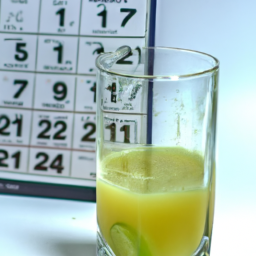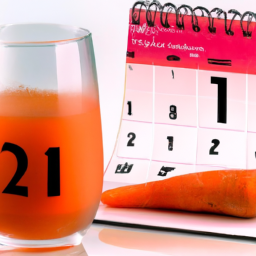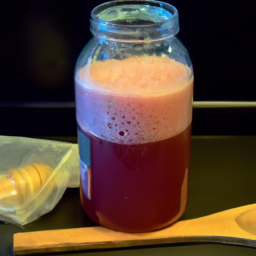As someone who loves cooking and trying new flavors, I often use fresh lime juice to enhance my recipes. It’s important to be aware of the shelf life of fresh lime juice to avoid ruining a dish or risking your health by using spoiled juice.
In this article, I will explore the shelf life of fresh lime juice, the signs that it has gone bad, and tips for storing it properly to ensure maximum freshness and flavor. Fresh lime juice is a versatile ingredient that can be used in various dishes, from marinades and dressings to cocktails and desserts. However, its shelf life can vary depending on several factors, such as how it is stored and whether it is pasteurized or not.
By understanding how long fresh lime juice can last and how to properly store it, you can make the most of this delicious ingredient and elevate your culinary creations. So, let’s dive into the world of lime juice and explore its shelf life and storage options.
Key Takeaways
- Fresh lime juice should be used within a few days of juicing and signs of spoilage include sour smell, discoloration, and cloudiness.
- Proper storage is crucial for preserving flavor and freshness, with glass containers preferred and refrigeration necessary (avoid freezing).
- Bottled juice often contains additives and preservatives, while fresh juice has higher Vitamin C concentration and is important for best flavor.
- Using fresh lime juice is versatile and adds a zesty kick to cocktails, marinades, salsas, guacamole, and grilled dishes. Lemon juice and various types of vinegar can also be used as substitutes.
The Shelf Life of Fresh Lime Juice
The shelf life of fresh lime juice is a topic of concern for many home bartenders and mixologists alike, as it can quickly deteriorate after just a few days. The best way to ensure that your lime juice stays fresh for as long as possible is to store it properly.
Once you’ve cut open a lime and juiced it, it’s important to immediately transfer the juice to an airtight container and store it in the refrigerator. This will help to slow down the oxidation process and preserve the flavor of the juice.
If you’re using fresh lime juice in your cocktails, it’s important to note that using expired lime juice can have an impact on the taste of your drinks. Expired lime juice can become bitter and sour, which can negatively affect the overall flavor of your cocktails.
To avoid this, it’s best to use fresh lime juice whenever possible and to discard any juice that has gone bad. With proper storage and handling, you can enjoy fresh lime juice for up to a week. But how do you know when your lime juice has gone bad? Let’s take a look at some of the signs to watch out for.
Signs that Your Lime Juice Has Gone Bad
When your lime liquid has turned sour and smells funky, it’s time to toss it. But before you throw it out, there are ways to salvage bad lime juice. One method is to add a pinch of salt or sugar to the juice to balance out the acidity. Another is to dilute it with water or another liquid to reduce the tartness. However, if the juice has already reached a point where it is too acidic, it’s best to just get rid of it.
So how do you tell if lime juice is too acidic? One way is to taste it. If it makes your mouth pucker and feel uncomfortable, it’s probably too acidic. Another way is to look for discoloration or cloudiness in the juice, which could indicate that it has spoiled.
In general, it’s best to use fresh lime juice within a few days of juicing to ensure it’s at its peak freshness and acidity. Using fresh lime juice is important for achieving the best flavor in your recipes.
In the next section, we’ll discuss the benefits of using fresh lime juice and how it can elevate your dishes.
The Importance of Using Fresh Lime Juice
By using freshly squeezed lime juice, you can enhance the flavor profile of your dishes and bring out the natural acidity that complements a variety of flavors. The benefits of using fresh lime juice are numerous, including a brighter taste that adds a zing to your dishes.
Additionally, freshly squeezed lime juice has a higher concentration of Vitamin C, which is essential for maintaining a healthy immune system. On the other hand, using bottled lime juice can have its drawbacks. Bottled lime juice often contains additives and preservatives that can affect the taste and quality of your dishes.
Moreover, bottled lime juice may not have the same level of acidity as fresh lime juice, which can impact the overall flavor of your dish. In short, using fresh lime juice is a must if you want to take your cooking to the next level and ensure that your dishes taste their best.
When it comes to storing lime juice, there are several tips that can help you keep your juice fresh for as long as possible.
Tips for Storing Lime Juice
When it comes to storing lime juice, there are a few key factors to keep in mind to ensure its freshness and quality. First, choose the right container – opt for a glass container with an airtight lid to prevent oxidation.
Keeping the juice at the right temperature is also crucial – refrigerate it at 40°F or below to prolong its shelf life.
Finally, avoid contamination by using clean utensils and surfaces. This can prevent bacterial growth and ensure the juice stays safe to consume.
Choosing the Right Container
To keep your lime juice fresh and flavorful, it’s essential to choose the right container. You should opt for a tightly sealed glass bottle or jar with a lime symbol etched on it. This will not only prevent spillage but also ensure that your lime juice stays fresh for a longer time.
Glass containers are preferred over plastic ones as they don’t react with the lime juice and keep it fresh for a longer time. Avoiding spillage is crucial while choosing the container for your lime juice. A tight seal will prevent air from entering the container, which can cause the juice to spoil quickly.
Once you have the right container, you can move on to the next step of keeping it at the right temperature.
Keeping it at the Right Temperature
Now that we’ve discussed the importance of choosing the right container for storing fresh lime juice, let’s talk about the next crucial aspect of keeping it fresh: temperature control. Proper storage methods are key to ensuring that your lime juice stays fresh and safe to consume. By controlling the temperature, you can prevent the growth of harmful bacteria and extend the shelf life of your lime juice.
Here are some tips for temperature control and storage methods when it comes to fresh lime juice:
- Keep your lime juice refrigerated at all times.
- Store your lime juice in an airtight container to prevent air exposure, which can cause oxidation and spoilage.
- Avoid freezing your lime juice, as this can alter the taste and texture.
- Use your lime juice within one week of opening for optimal freshness.
By following these simple temperature control and storage methods, you can keep your fresh lime juice safe and delicious for longer.
Now, let’s move on to the next step in ensuring the safety of your lime juice: avoiding contamination.
Avoiding Contamination
Ensuring the safety of your lime juice is crucial, so it’s important to take steps to avoid contamination. One way to prevent oxidation and keep your lime juice fresh is by using preservatives. Commonly used preservatives include citric acid, ascorbic acid, and sodium benzoate. These preservatives inhibit the growth of bacteria, mold, and yeast, which can cause spoilage and affect the taste and quality of your lime juice.
Another way to avoid contamination is by properly cleaning and sanitizing all equipment and surfaces used in the preparation, storage, and serving of your lime juice. This includes cutting boards, knives, juicers, containers, and utensils. Use hot, soapy water to clean these items and then sanitize them with a solution of one tablespoon of bleach per gallon of water. Be sure to also wash your hands thoroughly with soap and water before handling any ingredients or equipment. By taking these precautions, you can ensure that your lime juice stays fresh and safe to consume.
To learn how to extract lime juice properly, refer to the next section.
How to Extract Lime Juice
Hey there, looking to extract some fresh lime juice? Squeeze those green beauties until they’re bursting with tangy goodness, and you’ll have a zesty addition to any dish or drink. Here are four steps to help you extract the most juice from your limes:
-
Start by rolling the lime on a hard surface. This will break down the fibers inside and make it easier to extract the juice.
-
Cut the lime in half crosswise, not lengthwise. This will allow you to easily squeeze the juice out of each half.
-
Use a citrus juicer or a fork to extract the juice from each half. If you’re using a fork, simply press it into the flesh of the lime and twist it back and forth to release the juice.
-
Strain the juice through a fine mesh sieve to remove any pulp or seeds.
Now that you know how to extract lime juice, let’s talk about the benefits of lime juice and different ways to use it.
Lime juice is packed with vitamin C and antioxidants, making it a great addition to your diet. It can also be used in a variety of ways, such as:
- Adding it to marinades for a tangy flavor
- Mixing it with honey and ginger for a refreshing drink
- Squeezing it over grilled meats or seafood for a citrusy kick
- Using it in desserts, like key lime pie or lime sorbet
With so many ways to use lime juice, it’s a versatile ingredient that can add flavor to any dish.
In the next section, we’ll explore some delicious recipes that use lime juice to get your taste buds tingling.
Recipes that Use Lime Juice
Get ready to tantalize your taste buds with these amazing recipes that use zesty lime juice! Lime juice is a versatile ingredient that can add a burst of flavor to any dish.
One popular way to use lime juice is in cocktails. A classic example is the Margarita, which combines lime juice, tequila, and triple sec for a refreshing and tangy drink. Another popular cocktail is the mojito, which features lime juice, mint, and rum for a sweet and minty flavor. Lime juice can also be used in non-alcoholic drinks like limeade or as a garnish for a Bloody Mary.
Aside from cocktails, lime juice is also great for marinades. The acidity in the lime juice helps to tenderize meat while adding a bright and tangy flavor. A simple marinade can be made by combining lime juice, olive oil, garlic, and salt. This can be used for chicken, fish, or shrimp. Lime juice can also be added to salsas or guacamole for an extra kick of flavor.
Overall, lime juice is a versatile ingredient that can be used in a variety of recipes to add a tangy and refreshing taste.
Looking for alternatives to lime juice? Try using lemon juice or vinegar for a similar acidic flavor. These alternatives can be used in the same way as lime juice in marinades or dressings. Another option is to use citrus fruits like grapefruit or orange for a different twist on the classic lime flavor. With so many options, you can experiment with different ingredients to find the perfect flavor for your dish.
Alternatives to Lime Juice
As someone who loves to cook, I know that sometimes it can be frustrating when you don’t have all the ingredients you need.
When it comes to lime juice, there are some great alternatives that can be used in a pinch. Lemon juice is a great substitute that can give a similar flavor profile, while vinegar can add a tangy note. Additionally, other citrus fruits such as oranges or grapefruits can also work well in certain recipes.
So, next time you’re out of lime juice, don’t fret! You have plenty of other options to choose from.
Lemon Juice
If you’re trying to figure out how long your lemon juice will stay good for, it’s important to store it properly and keep an eye on the expiration date. Lemon juice is similar to lime juice in that it has a sour taste and provides health benefits such as being high in vitamin C and antioxidants.
Here are a few tips to keep your lemon juice fresh:
- Store in a sealed container in the refrigerator.
- Use within 2-3 days of opening.
- Check the expiration date on the bottle before using.
Now, if you’re looking for another alternative to lime juice, vinegar may be a good choice. It has a tangy taste that can be used in similar ways to lime juice, such as in salad dressings and marinades.
Vinegar
Moving on from lemon juice, let’s talk about vinegar. As a chef, I always have a bottle of vinegar within reach. Vinegar is a versatile ingredient that can be used in cooking, cleaning, and even as a beauty product. The benefits of vinegar are numerous, making it one of the most popular ingredients in the kitchen.
There are different types of vinegar, each with its unique flavor and acidity. The most common types of vinegar are white vinegar, apple cider vinegar, balsamic vinegar, and red wine vinegar. White vinegar is a pantry staple that can be used in pickling, marinades, and dressings. Apple cider vinegar is known for its health benefits and can be used in cooking and as a natural remedy. Balsamic vinegar is a sweet and savory vinegar that can be used in salads, roasted vegetables, and meats. Lastly, red wine vinegar has a bold flavor that pairs well with strong-flavored dishes.
Now, let’s move on to other citrus fruits and their shelf life.
Other Citrus Fruits
Let’s explore some other citrus fruits and how they can add a zesty punch to your meals. Citrus fruits are a great way to bring flavor and nutrition to your dishes. Here are three citrus fruit pairings that can take your cooking to the next level:
-
Lemon is an incredibly versatile citrus fruit that can add brightness to savory dishes, desserts, and drinks. It’s also packed with vitamin C and antioxidants that can boost your immune system and protect against chronic diseases.
-
Orange is another citrus fruit that can add a burst of sweetness and acidity to your meals. It pairs well with spicy ingredients and can be used in salads, marinades, and desserts. It’s also rich in vitamin C, folate, and potassium, which can support heart health and reduce inflammation.
-
Grapefruit is a tangy and bitter citrus fruit that can add a refreshing taste to your meals. It’s a great source of vitamin C, fiber, and antioxidants, which can improve digestion, lower cholesterol, and prevent cancer.
Incorporating these citrus fruit pairings into your meals can not only enhance the flavor, but also provide numerous health benefits.
Now, let’s move on to the next section about using frozen lime juice.
Using Frozen Lime Juice
Using frozen lime juice is a great way to enjoy the refreshing taste of lime throughout the year. Not only does it save the hassle of squeezing fresh lime juice, but it also has a longer shelf life. Frozen lime juice can be used in a variety of recipes, including cocktails, marinades, dressings, and soups.
Here are some benefits of using frozen lime juice:
| Benefit | Explanation |
|---|---|
| Convenience | Frozen lime juice can be easily stored and used whenever needed. |
| Cost-effective | Buying frozen lime juice in bulk can be more affordable than purchasing fresh limes. |
| Consistency | Frozen lime juice has a consistent flavor and acidity level, ensuring that every dish tastes the same. |
| Availability | Frozen lime juice is available year-round, making it easy to incorporate lime flavor into any recipe. |
Incorporating frozen lime juice into your diet can be a great way to add a burst of flavor and acidity to your meals. But, it’s important to note that while frozen lime juice has a longer shelf life, it still should be used within a reasonable time frame to ensure optimal flavor. Let’s explore some ways to incorporate lime juice into your diet.
How to Incorporate Lime Juice into Your Diet
Now that we know frozen lime juice can be a worthy substitute for fresh lime juice, let’s talk about the benefits of incorporating it into your diet.
Lime juice is a great source of vitamin C, which is important for maintaining healthy skin, hair, and immune system. It also contains antioxidants that can help fight inflammation in the body.
There are many different ways to use lime juice in cooking. You can use it as a marinade for meats, add it to salad dressings, or use it to flavor drinks and desserts. Lime juice can also be used in place of vinegar in recipes, giving dishes a tangy and refreshing flavor.
By adding lime juice to your meals, you can not only enhance the taste of your food but also reap the health benefits that come with it.
Frequently Asked Questions
Can you freeze fresh lime juice?
Looking to preserve lime juice? Wondering if you can freeze fresh lime juice? Absolutely! Freezing fresh lime juice is an easy way to extend its shelf life and keep it available for later use. Just be sure to use a freezer-safe container.
How long does bottled lime juice last compared to fresh lime juice?
I’ve compared bottled and fresh lime juice in terms of taste and nutrition. While bottled juice may be convenient, fresh juice has a brighter taste and higher vitamin C content. It’s best to use fresh juice within a few days for optimal flavor.
Can you use lime juice that has been left out at room temperature for a few hours?
I once left lime juice out and it turned brown and lost its flavor. To prevent this, use room temperature lime juice immediately or try preservation techniques such as refrigeration or freezing.
How do you know if a lime is ripe enough to extract juice from it?
To select a ripe lime for optimal juice extraction, look for one that is heavy for its size, has smooth skin, and yields slightly to pressure. Roll the lime on a hard surface before juicing to release more juice.
Are there any health benefits to consuming fresh lime juice regularly?
Drinking fresh lime juice regularly can provide numerous health benefits such as boosting immunity and aiding digestion. Adding it to recipes can also enhance flavor and nutrition. It’s a simple and tasty way to improve overall wellness.
Conclusion
In conclusion, fresh lime juice is a versatile ingredient that can add a burst of flavor to any dish or drink. Its tangy taste and high acidity make it a popular ingredient in many cuisines, including Mexican, Thai, and Indian.
However, using old or spoiled lime juice can ruin the taste of your dish and even pose health risks. To truly appreciate the benefits of fresh lime juice, it’s important to understand its shelf life and proper storage techniques.
By following the tips outlined in this article, you can ensure that your lime juice stays fresh and flavorful for longer. So whether you’re making a margarita, a ceviche, or simply adding a squeeze of lime to your water, remember to always use fresh lime juice for the best results.
Ilana has been a vegan for over 10 years. She originally made the switch for health reasons, but soon found herself becoming more and more passionate about the ethical and environmental implications of a vegan lifestyle. Ilana is the author of The Graceful Kitchen, a blog all about veganism. She loves to cook up delicious and nutritious vegan meals, and share her recipes with others who are interested in leading a cruelty-free life. Ilana is also a strong advocate for using whole foods as the foundation of a healthy diet, and believes that going vegan is one of the best ways to achieve this.










